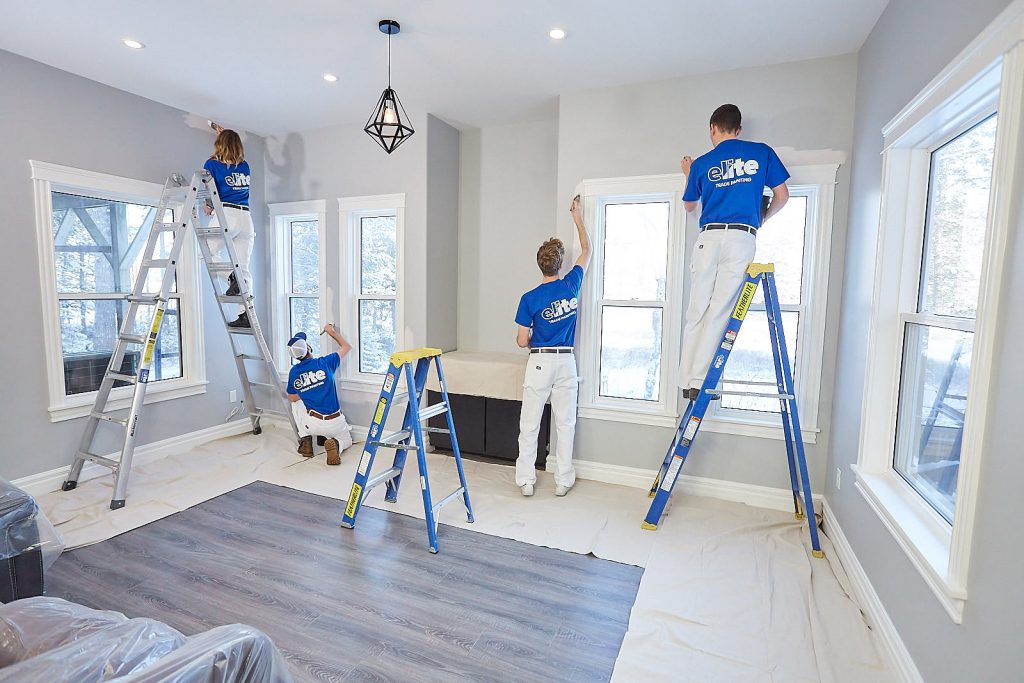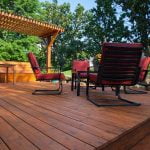Paint-enance 101: Maintaining and Cleaning Your Paint Inside the Home

Like most things, your paint is going to need cleaning and maintenance over time to keep it in its best condition. Scuffs, stains, spills, and other problems can make even the best paint look shabby, old, and in need of some attention.
In this guide, we’ll take a look at how to clean and maintain all the painted surfaces in your home. That way, you can guarantee that your paint looks its best as long as possible, or until your next repaint!
How Often to Clean Painted Walls and Surfaces

You should spot-clean your painted surfaces as messes happen or are discovered. The sooner that you get the mess cleaned up, the less likely it is to either stain the wall or damage the paint irreparably. As for full cleaning, that can be done about once a year.
You’ll want to make sure that you choose gentle materials and cleaning solutions for this process so that you don’t cause damage to the paint’s finish or worse, remove it entirely. Forget about all those wall cleaners and chemical products that claim to get painted surfaces clean with ease. Those can often do more damage than they are worth. Plus, they’re not really necessary.
The good news is that you’ll usually have everything that you need on hand for spot-cleaning. Just take a look in your kitchen – we list below everything you might need.
What Will I Need?
A lot of people are tempted to buy all those fancy cleaning products that claim to remove stains and restore paint finishes. And why not? With claims of “quick” and “easy” cleaning, who wouldn’t mind spending a little money here?
You don’t have to, though. In fact, you shouldn’t use these cleaners unless you have already tried the following methods of cleaning your painted surfaces. Don’t forget to test a small area first, so that you can make sure that it won’t damage the paint. Even those “magic erasers” can remove certain types of paint if you’re not careful.
The best place to start? Use this list of supplies:
- A soft sponge
- A soft cloth
- A microfiber cloth
- Dish soap and warm water
- Baking soda
- White vinegar
Sponges and Cloths
Painted surfaces are delicate by nature, even with the hardest paint and finishes. Therefore, you will always want to use a soft sponge and cloth when cleaning. If there are tough spots, you may need a little extra elbow grease but no need to get yourself some steel wool. You can also apply a concentrated cleaning mixture of dish soap and vinegar to help remove stubborn stains and marks.
Dish Soap
So many people overlook the value of regular, everyday dish liquid. Especially when you choose quality brands, you’ll find that this can do a lot more cleaning than you might expect. Warm water and a little soap can do wonders to clean your walls. Make sure that you dilute the mixture enough that it doesn’t actually leave suds or residue. If you do leave some suds behind, taking a wet cloth afterwards to wipe down the area will do the trick.
Baking Soda
Baking soda is a neutralizer. It is also abrasive and natural, which allows it to give you that extra scrubbing power without risking the finish of the paint. You can avoid a lot of damage and harsh chemicals by adding this to your list of supplies for cleaning your paint.
White Vinegar
This is another natural cleaning wonder. Vinegar is great at breaking down stains and removing greasy buildup. If you’re cleaning kitchen cabinets, choose a vinegar solution for the best results.
And that concentrated cleaner we mentioned? It consists of one teaspoon of liquid dish soap and ¼ teaspoon of white vinegar. Mix them, apply them to the stain or stubborn area for about 10 minutes, and then blot the cabinets with a microfiber cloth. Then, you can use the sponge to wipe everything clean.
Prepare the Painted Surfaces for Cleaning
Before you start putting liquids on the surface, you will want to wipe it down with a dry cloth or feather duster or use a vacuum attachment to remove excess dust and debris. A damp rag can help remove stubborn dust layers before you start cleaning.
You should also lay a towel or drop cloth under the surfaces you’re cleaning to catch any liquids and keep the process neat and tidy. If you want, you can stop by the dollar store and pick up a cleaning caddy that you can use to tote your supplies around as you clean, and you’ll be ready to go for your next big mess on your paint.
The Cleaning Process: Different Steps for Different Finishes
Although cleaning painted surfaces is a fairly straightforward process, it may vary slightly based on the type of paint you are cleaning. For example, you can’t scrub a matte finish as hard as a high-gloss paint because it might leave dull spots on the wall where the finish is removed.
Let’s take a look at how to clean your walls and painted surfaces based on the type of paint finish you’re dealing with.
Flat (Matte), Satin and Eggshell Finishes
Use a cloth or soft sponge to gently rub the wall and remove the scuff or spill. Try to catch things as they happen so that they don’t set in and become difficult to remove. You can use vinegar if water doesn’t work on its own but remember to be gentle with your scrubbing still.
Skip magic erasers for these walls because that’s the fastest way to create those rubbed-out spots where you have removed paint. Don’t use chemicals if you can help it, either, because they’re more likely to damage the finish. If you have stubborn stains, you can use the concentrated cleaner from above.
Semi-Gloss Finish
This is the paint finish you’ll probably find on your trim, doors, bannisters, etc. This paint is made to be washed and cleaned, so the good news is that your job just became a lot easier.
You can also scrub these surfaces more than you can with matte and other delicate finishes, which makes them desirable for many people. You can simply use warm water and liquid dish soap to clean the paint, or you can add white vinegar if you need a little extra cleaning power.
Make sure that you’ve got a warm bucket of clean water for rinsing after you clean. Clean the surface using small, circular scrubbing motions, rinse the surface by wiping it with a cloth from the clean water, and you’re done. If you have stubborn spots, again you can use that concentrated cleaner we discussed earlier.
High-Gloss Finish
A lot of people love high-gloss paint because it offers an impressive shine and simple maintenance. However, it’s also likely to be affected by abrasive materials and cleaners, so you will need to proceed with caution. Use a soft cloth with warm water to start, and as with the other finishes, you can add the extra cleaning solution for stubborn spots.
If you’ve tried warm water, vinegar, baking soda, and other household cleaners and you still have stubborn stains, you may be able to use paint cleaning products that are store-bought. However, you’ll still want to avoid harsh chemicals and abrasive cleaners that can potentially cause more harm than good.
Tips for Keeping Your Painted Surfaces in Good Condition
Regular cleaning is the best way to keep your painted walls and furniture looking their best. Maintenance goes a long way in saving you from having to repaint too often, which can get costly.
Here are some tips to help you keep your paint looking its best, whether it’s on walls, furniture, or anywhere else in your home.
- Dust and wipe down painted surfaces regularly. This includes dry dusting and wiping with a damp cloth. This will help to remove a lot of the routine dirt buildup and save from big cleaning jobs in the future. It will also keep your paint looking its best at all times.
- “Regular” cleaning for painted surfaces may mean different things to different people. Dusting and wiping down things like cabinets for example, should be done weekly or bi-weekly, depending on how much dust builds up in your home. Fully cleaning walls, however, may be a once-a-year job. Make sure that you know what needs to be done and when.
- Use coasters on flat surfaces to prevent damage from dishes, condensation on beverage containers, and so forth. Avoid sitting items on a painted surface that may scuff, scratch, or mark it in some way.
- If it’s been more than five years, it might be time for a fresh coat of paint. Even with the best cleaning and maintenance, paint just wears over time. The bonus here is that you can choose a new color and create a whole new look for your home.
- Consider calling in professional cleaners or painters to help you with your walls and other painted surfaces. DIY is great, but it’s only going to get you so far.
- Remember to avoid harsh chemicals and abrasive cleaning supplies at all costs. While it might seem like they are good for scrubbing power, they’ll also scrub the paint right off in many cases.
Aren’t Chemical Cleaners Made to Be Stronger?
Stronger, yes. Safer? Absolutely not. A trip to your local home improvement or paint store will reveal all manner of cleaning products and supplies that you can use to keep painted surfaces in good condition. Just because these products exist doesn’t mean you should use them.
Chemicals can be corrosive, flammable, and may irritate the eyes, lungs, and skin. Many chemicals can actually remove paint instead of cleaning it, which means you’ll end up needing to make small touch-ups and repairs. If you do find yourself exploring pre-made paint cleaning products, make sure they are:
- Organic and free from harsh chemicals or abrasive cleaners
- Recommended by professional painters
- Designed for the type of paint finish you have
This will reduce the risk of any issues if you find yourself going down this route.
When Cleaning Isn’t Enough
As mentioned, there may come a point where even with the best cleaning methods, your painted surfaces start to appear dull, lose their luster, or show signs of wear and damage. This might mean that it’s time to consider repainting. Consider whether you’ve got the budget for painting right now or start saving for your project.
Reach out to professional painters, who can come in and assess the situation to help you decide how to proceed. They will be able to examine your home’s walls or other painted surfaces to determine whether they’re in good shape or if you should consider a full paint job instead of just cleaning things up.
Most professional painters will be able to provide insight and assistance with cleaning, fixing repairs and damage, and other needs you will have. And even though painting is going to cost more than cleaning, depending on your paint’s condition it may be your best choice. If you refresh one or two rooms at a time, that can help spread out the cost.
So, you’ve cleaned your walls and other painted surfaces, but they’re still not shining the way you’d like. What can you do? Reach out to the experts at Elite Trade Painting to discuss repainting services for your home. From the walls to the ceilings to built-ins and more, we can handle all of your interior painting needs. Schedule an estimate with us today to learn more about refreshing your home with new paint.
 (877) 663-5483
(877) 663-5483 (844) 333-1387
(844) 333-1387



